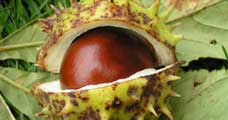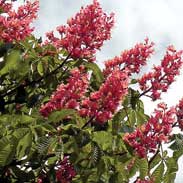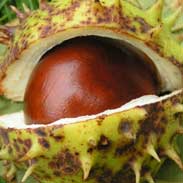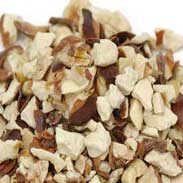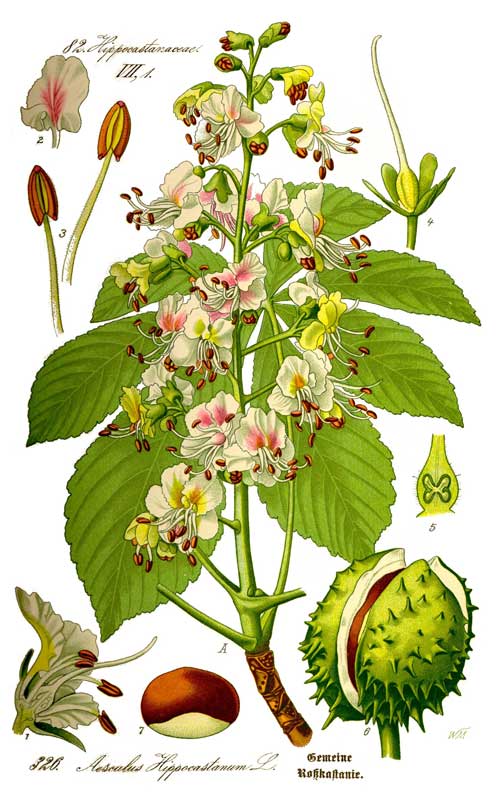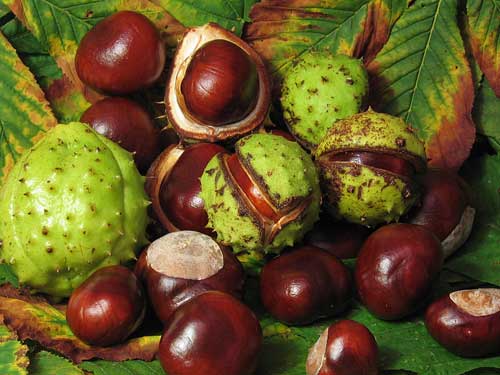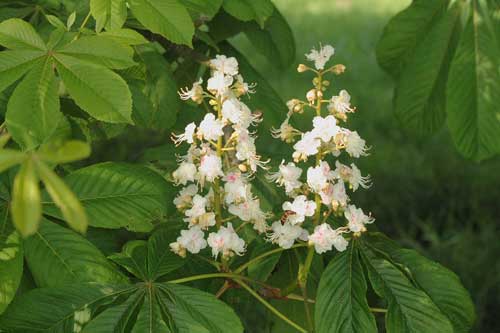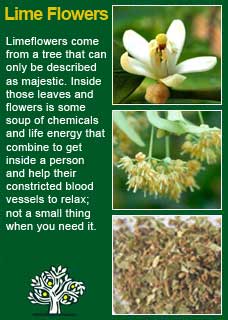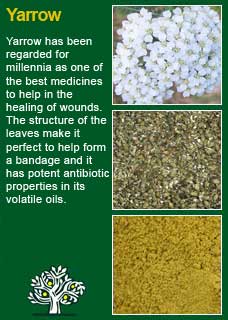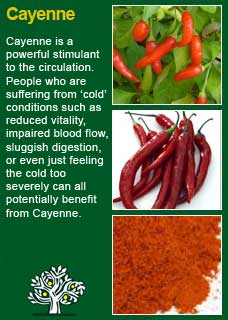
|
|
||||
| Our Pages ABOUT CONSTITUTIONAL MEDICINE
|
In herbal medicine it is sometimes the bark but primarily the ‘fruits’ (perhaps more accurately described as the nuts) that are used from the Horse-chestnut tree. Horse-chestnuts can grow to nearly 40 meters tall and they are often planted in parks and botanical gardens because of their grace, beauty, abundant foliage and striking flowers.
Horse-chestnut has a long history of use for improving circulation and the strength of the blood vessels. This has seen it being taken internally for conditions such as excessive uterine bleeding, varicose veins and bleeding haemorrhoids. A tea made from Horse-chestnut has also been used externally to treat similar problems such as chronic leg ulcers or open wounds where the blood vessels on the surface are not mending themselves well. King's Dispensatory writes 'Horse-chestnut's power over the circulation is pronounced, particularly its control over the portal vessels. Gangrenous and ill-conditioned ulcers have-been benefited by a strong infusion of the bark. The whitish, central part of the nuts, when in powder, has been recommended as a sternutatory in some cases of ophthalmia and headache. Specific medication has taught us that it is a remedy, not for active conditions, but for congestion and engorgement. It is indicated in general by capillary engorgement—a condition of stasis—with vascular fullness and sense of soreness, throbbing, and malaise all over the body. An uneasy, full, aching pain in the hepatic region is also an indication. Rectal disorders, such as rectal irritation and haemorrhoids, with marked congestion and a sense of constriction, as if closing spasmodically upon some foreign body, with itching, heat, pain, aching, or simple uneasiness, are fields in which Horse-chestnut exerts a specific influence' Rudolph Weiss M.D writes 'today it is a proven fact that standardised Horse-chestnut extract is an effective preparation for the treatment of chronic venous insufficiency'. D Hoffmann writes 'Horse-chestnut has unique actions on the vessels of the circulatory system. The herb appears to increase the elasticity and tone of the veins while decreasing vein permeability. It may be used internally in the treatment of phlebitis, (vein inflammation) varicosities, and haemorrhoids. Externally, it may be used for the same conditions, as well as for leg ulcers. Aescin (an ingredient of Horse-chestnut) has antiexudative actions and a tightening effect on the vasculature. A study of 22 patients with venous insufficiency showed that 1200mg of Horse-chestnut extract (standardised to 50mg aescin per capsule) lowered capillary filtration by 22% in 3 hours. A review of 13 clinical studies reported that Horse-chestnut was superior to placebo in improving symptoms of chronic venous insufficiency. The pooled results showed that Horse-chestnut reduced oedema, pain, fatigue, tenseness and in some cases pruritis in the legs. Commission E recommends a total daily dose of 100mg aescin, which corresponds to 250-312.5 mg of Horse-chestnut extract' Thomas Bartram writes that the actions of Horse-chestnut include 'anti-inflammatory, vasodilator, astringent, tones & protects blood vessels, anti-oedema. Stimulates production of prostaglandin F-alpha, which constricts veins. He suggests uses for it including 'for bleeding piles and uterine bleeding, varicose veins, phlebitis, heavy legs, swollen ankles, chilblains, thrombo-phlebitis, night cramp (take 20 drops of the tincture at bedtime) Bartram suggests doses for the horse-chestnuts of 1-2 grams and 1-2 mls of the extract of the powdered herb in tincture form.
~ Horse-chestnut has been the subject of some intriguing and compelling studies that show it to be a potent and active medicine with much to offer in its sphere of influence: ~ A review of no less than 14 randomised, double-blind, controlled studies showed that Horse-chestnut categorically helps the symptoms of chronic venous insufficiency. A dosage of 600mg a day of Horse-chestnut extract was used in the majority of the trials. Adverse effects were mild and infrequent (Pittler MH, Ernst E: Altern Ther Health Med 7(3):108, 2001) ~ A case observation study involving more than 800 German GPs and over 5000 patients with chronic venous insufficiency showed that Horse-chestnut extract improved symptoms markedly. Horse-chestnut was considered an economical, practice-relevant therapeutic tool that had better patient compliance than compression-stocking therapies (Leskow P. Therapiewoche 1996; 46:874-877) ~ A significant reduction in leg volume was recorded after Horse-chestnut treatment in pregnant women with varicose veins and Horse-chestnut extract increased vascular blood flow in healthy volunteers in a double-blind, placebo-controlled study (Erler M. Med Welt 1991; 42:593-596) ~ There are over 100 published studies and articles on Horse-chestnut, a PDF showing their titles, authors and when and where they were published can be found here
For some years now, against this proven and safe way of herbalism, there has been a rising tide of excessive caution and scare-mongering in many parts of the world. The same authorities that, not so long ago, decried herbal medicines as ineffectual, have now taken up a different adversarial position; that they are dangerous substances that should only be prescribed by Doctors, who of course have zero training in them. Unfortunately, the same unnecessary fear and worry has crept into many natural health websites and popular publications on herbs. Herbs that we have safely used for thousands of years, that have no reports of adverse reactions in the medical literature despite widespread use by millions of people, are suddenly described as contraindicated because of something that should have been seen as completely unimportant, or at the utmost a merely theoretical concern, such as a laboratory study on one of the herb's constituents to use an all too common example. I wonder sometimes if the writers of such articles feel that the herb will be more deserving of respect if it is thought to be a little bit dangerous, in other words more like a drug than something that has simply come out of the earth and been used by ordinary people for generations beyond count. There is just so much misinformation about herbal medicine on the internet now. Ludicrous claims and cautions abound in equal measure; it seems like one group are trying to make money out of the public whilst the other are busily trying to scare them off. I have to believe that the kind of reader who takes the time to read pages on herbs that are as extensive as this one is much less likely to be swayed by marketers or misinformers. I hope that you will keep your wits about you if you get conflicting opinions from people who have never really got to know these herbs, who have never worked with them, or learned how to use them safely and effectively. I want to remind you that the reason that herbs can never be patented and owned by any individual or corporation is because they are, and always will be, the People's medicine. They belong to all of us and it is my great hope in sharing this work that you will learn how to use them wisely for yourself, and the people you care for. Be safe, but do not be afraid.
I have had a great many good results in my own practice with the use of Horse-chestnut for the treatment of varicose veins and other conditions of poor blood flow through the veins and so for some time now I have felt confident to suggest it as a treatment which will have a high likelihood of success. Varicose veins are a tough problem to treat and most people are told there is no solution other than a surgical one but, based on my own experience with it, I can say that a wider appreciation and use of Horse-chestnut would see a great deal of surgical ‘stripping’ of varicose veins being able to be avoided.Horse-chestnut clearly has ingredients within it that make it remarkably effective at strengthening weakened blood vessels. I have also found Horse-chestnut to be of value in some cases of another tricky condition; acne rosacea. Here it seems that, if taken for long enough, it seems to reduce the propensity of the blood vessels of the face to haemorrhage and form broken capillaries over the nose, cheeks and forehead. Horse-chestnut is a very strong herb and you have to be careful not to overdo it or you can get some symptoms of nausea. In any case I don't think that especially high doses are needed for a good result but rather it needs to be taken consistently and patiently for at least 2 months before deciding if it might be doing some real good. There are many commercial products of this herb available and if someone is confident of the authenticity of their source of supply then any preparation that provides around 600mgs a day of high-quality Horse-chestnut extract should be sufficient to see it working. Horse-chestnut combines perfectly with Limeflowers and Yarrow to strengthen blood vessels and with Cayenne or Hawthorn to improve circulation. A common example of how I use it in practice is given below.
These two herbs have been seen to be of much help to some people with varicose veins or other forms of venous weakness, but you cannot expect fast results with them. A minimum of two-three months' treatment is necessary before you can assess if they are making a significant difference and then, if they are, you must carry on with them for as long as necessary. We make our own tinctures from raw material and, the right dosage being such a critical part of the success of any herb or drug, it is impossible to equate exactly how much we give to another product but, by way of example, a typical treatment program with these herbs might look something like
The Licorice is there for taste and to make it easier to digest the Horse-chestnut in particular, someone with an aversion to Licorice could use Peppermint or Fennel extracts instead. This formula would make 560mls, which will just fit into a 500ml bottle. A typical adult dose would be 10mls once a day but a person who was in a bad way could take 10 mls twice a day until things were clearly improving. At once a day, this amount of medicine would take 2 months to complete, whereupon I would recommend at least one repeat to give it all a proper try. In other words, I would usually want to do a 3-4 month treatment of these herbs to see how much difference they could make. At 10 mls once a day, this formula would give about 2 mls of Horse-chestnut extract in a day, which should be both safe and adequate, so long as it is given enough time to work.
Much of the information here about the traditional uses of Horse-chestnut is consistent with the model of thinking whereby one may treat problem A with plant B. There is value in this approach, especially in how it helps us pass on useful knowledge to one another, but it falls short in one vital area; and that is that people are not all cut from the same cloth! Something that works brilliantly for one person may do less for another -- why is this? Part of the reason is that people vary in their constitutions as to whether they are either hotter or cooler and, at the same time, either dryer or damper. This useful and rather fascinating subject is introduced further here Another big part of using the right herb when it is most needed comes from understanding the need to treat what is going wrong for the person that had led up to their getting a health condition. In this light, Horse-chestnut can particularly offer its benefits when a nourishing action is needed in the 'cycle of healing', more about this here
Please understand that I cannot advise you, including on products or dosage, without seeing you in person in my clinic but for ideas
on how you might find a good herbalist in your area read here |
|
|
|
© 2011 R.J.Whelan Ltd
